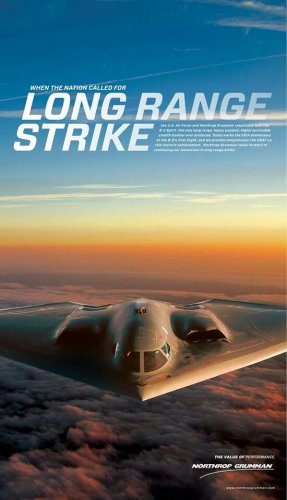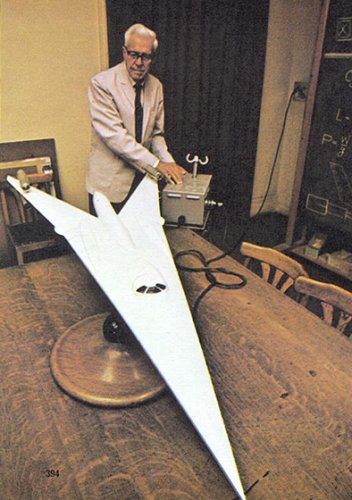- Joined
- 21 April 2009
- Messages
- 13,149
- Reaction score
- 5,996
Air Force Releases Long-Range Strike Bomber Request For Proposals
Posted: Jul. 10, 2014
The Air Force announced on July 10 that it has released a highly anticipated request for proposals for the Long-Range Strike Bomber. The service issued the RFP July 9, officially moving the program into the competitive development phase.
"The RFP will lead to a competitive selection of the bomber's developer in the spring 2015 time frame," Air Force Secretary Deborah Lee James said in the July 10 statement. "The LRS-B is a top modernization priority for the Air Force. It will be an adaptable and highly capable system based upon mature technology. We look forward to industry's best efforts in supporting this critical national security capability." The Air Force wants to buy between 80 and 100 bombers that are to be capable of penetrating anti-access/area denial environments. The program's cost is currently estimated at $55 billion. Whether the source-selection process will be truly competitive was called into question by an analyst at the congressional research service last week. The service's release of an RFP appears to contradict that concern, but it remains to be seen until bids are submitted whether more than one team will compete for the program. A Boeing-Lockheed Martin team has already been formed to bid, and B-2 prime contractor Northrop Grumman is expected to as well. In a July 9 statement to Inside the Air Force, Northrop spokesman Tim Paynter said the company is positioned well to support the program.
"Northrop Grumman's design, production and sustainment of the B-2 Spirit stealth bomber, the bomber most recently produced for the U.S. Air Force, positions it well for the LRS-B program," Paynter said. "We are very interested in working with the Air Force to provide this critical capability for the nation." Boeing is the prime contractor for the B-52 and B-1 bombers. The Air Force did not make the RFP public and spokesman Ed Gulick said in a July 10 email that the service will not reveal the due date for proposals and indicated that the service will continue to limit the information it releases on the program. "This puts us officially in the competitive phase and greatly limits what we can say," Gulick said.
In a July 2 analysis, CRS military aviation specialist Jeremiah Gertler notes that the Air Force's latest spending plan for LRS-B research and development, which shows a jump from $259 million in fiscal year 2013 to $3.45 billion in FY-19, does not reflect the normal development curve of an early development program. Instead, he wrote, it more resembles a procurement curve for a program that is in the late stages of development. "Aviation analysts and industry officials confirm CRS's assessment that this funding stream resembles a production program more than a typical development profile," Gertler writes. "This may indicate that significant LRS-B development has already been completed, presumably in classified budgets. Such prior development would also help explain how the Air Force intends to get the system from a request for proposals to initial operational capability in about 10 years, when equally or less-complicated systems like the F-22 and F-35 have taken more than 20 [years]." Gertler said that if there has indeed been considerable prior development on the LRS-B, as past CRS reports and Air Force budget documents suggest, the Air Force will have difficulty constructing a truly competitive RFP. He said whichever competitor has performed the bulk of preliminary LRS-B development work will likely have the advantage when competing for the production contract.
While providing little detail about the nature of the early development work, the service has said that it is aimed at narrowing design requirements in order to avoid future program cost growth that comes with adding new capabilities late in development. According to a 2009 CRS report, which Gertler helped author, the Air Force funded the development of a next-generation long-range strike capability from FY-05 to FY-09. The government zeroed the line item in FY-10, the report states. In the service's FY-12 budget request, the development effort was restarted under the Long-Range Strike Bomber program, which replaced the earlier Next-Generation Bomber program. -- James Drew and Courtney Albon
Posted: Jul. 10, 2014
The Air Force announced on July 10 that it has released a highly anticipated request for proposals for the Long-Range Strike Bomber. The service issued the RFP July 9, officially moving the program into the competitive development phase.
"The RFP will lead to a competitive selection of the bomber's developer in the spring 2015 time frame," Air Force Secretary Deborah Lee James said in the July 10 statement. "The LRS-B is a top modernization priority for the Air Force. It will be an adaptable and highly capable system based upon mature technology. We look forward to industry's best efforts in supporting this critical national security capability." The Air Force wants to buy between 80 and 100 bombers that are to be capable of penetrating anti-access/area denial environments. The program's cost is currently estimated at $55 billion. Whether the source-selection process will be truly competitive was called into question by an analyst at the congressional research service last week. The service's release of an RFP appears to contradict that concern, but it remains to be seen until bids are submitted whether more than one team will compete for the program. A Boeing-Lockheed Martin team has already been formed to bid, and B-2 prime contractor Northrop Grumman is expected to as well. In a July 9 statement to Inside the Air Force, Northrop spokesman Tim Paynter said the company is positioned well to support the program.
"Northrop Grumman's design, production and sustainment of the B-2 Spirit stealth bomber, the bomber most recently produced for the U.S. Air Force, positions it well for the LRS-B program," Paynter said. "We are very interested in working with the Air Force to provide this critical capability for the nation." Boeing is the prime contractor for the B-52 and B-1 bombers. The Air Force did not make the RFP public and spokesman Ed Gulick said in a July 10 email that the service will not reveal the due date for proposals and indicated that the service will continue to limit the information it releases on the program. "This puts us officially in the competitive phase and greatly limits what we can say," Gulick said.
In a July 2 analysis, CRS military aviation specialist Jeremiah Gertler notes that the Air Force's latest spending plan for LRS-B research and development, which shows a jump from $259 million in fiscal year 2013 to $3.45 billion in FY-19, does not reflect the normal development curve of an early development program. Instead, he wrote, it more resembles a procurement curve for a program that is in the late stages of development. "Aviation analysts and industry officials confirm CRS's assessment that this funding stream resembles a production program more than a typical development profile," Gertler writes. "This may indicate that significant LRS-B development has already been completed, presumably in classified budgets. Such prior development would also help explain how the Air Force intends to get the system from a request for proposals to initial operational capability in about 10 years, when equally or less-complicated systems like the F-22 and F-35 have taken more than 20 [years]." Gertler said that if there has indeed been considerable prior development on the LRS-B, as past CRS reports and Air Force budget documents suggest, the Air Force will have difficulty constructing a truly competitive RFP. He said whichever competitor has performed the bulk of preliminary LRS-B development work will likely have the advantage when competing for the production contract.
While providing little detail about the nature of the early development work, the service has said that it is aimed at narrowing design requirements in order to avoid future program cost growth that comes with adding new capabilities late in development. According to a 2009 CRS report, which Gertler helped author, the Air Force funded the development of a next-generation long-range strike capability from FY-05 to FY-09. The government zeroed the line item in FY-10, the report states. In the service's FY-12 budget request, the development effort was restarted under the Long-Range Strike Bomber program, which replaced the earlier Next-Generation Bomber program. -- James Drew and Courtney Albon



